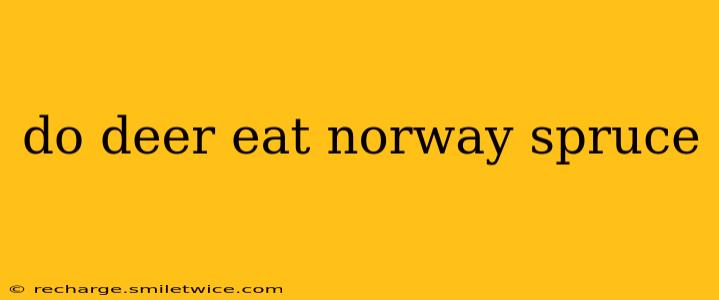Do Deer Eat Norway Spruce? A Deep Dive into Deer Browsing Habits
Deer, known for their varied diets, are often seen browsing on a wide range of plants. But do they include Norway spruce in their menu? The answer is nuanced, and understanding it requires exploring deer feeding behavior and the characteristics of Norway spruce.
The Short Answer: While deer generally avoid eating Norway spruce as a primary food source, they may occasionally browse on it, especially during harsh winters when other food sources are scarce. It's not their preferred choice, but desperation can lead them to consume it.
What Do Deer Typically Eat?
Deer are herbivores, with diets predominantly consisting of forbs (broadleaf herbs), grasses, shrubs, and twigs. Their preferred foods are highly nutritious and easily digestible. The nutritional content of a plant significantly influences a deer's decision to eat it. Factors like palatability (how tasty it is), availability, and nutritional value all play crucial roles.
Why Don't Deer Typically Eat Norway Spruce?
Norway spruce ( Picea abies) contains compounds that make it less palatable to deer. The needles are relatively tough and fibrous, making them difficult to digest. Furthermore, spruce needles contain higher concentrations of certain compounds that can be mildly toxic or simply unappealing to deer compared to their favored plants. Their digestive systems are simply better suited for softer, more nutritious vegetation.
When Might Deer Eat Norway Spruce?
The primary instance where deer might browse on Norway spruce is during periods of severe winter food scarcity. When snow covers the ground and traditional food sources are unavailable, deer might resort to eating less preferred plant material, including the needles and bark of Norway spruce. This survival behavior is driven by the sheer need to acquire calories and nutrients to stay alive.
What Other Trees and Plants Do Deer Eat?
Deer are opportunistic browsers, and their diets vary greatly depending on the season and the availability of food. Some commonly consumed trees and plants include:
- Maple trees: Deer love the leaves and twigs of various maple species.
- Oak trees: Acorns are a prized food source for deer, particularly in autumn.
- Birch trees: Deer browse on the leaves and twigs of birch trees.
- Willow trees: Willow branches are readily consumed.
- Various shrubs and forbs: Deer consume a wide variety of these plants, including clover, alfalfa, and many types of berries.
How Can I Protect My Norway Spruce from Deer?
If you are concerned about deer damaging your Norway spruce trees, several methods can help protect them:
- Repellents: Commercially available deer repellents can deter deer from browsing on your trees. These often need to be reapplied regularly, especially after rain.
- Physical Barriers: Fencing can provide effective protection, particularly for younger, more vulnerable trees.
- Tree Guards: These protective sleeves placed around the trunk of young trees can prevent deer from reaching the bark and lower branches.
Are there any long-term effects on deer if they eat Norway Spruce?
While not a preferred food source, consuming small amounts of Norway spruce needles is unlikely to cause significant harm to deer. However, relying heavily on it as a primary food source during extended periods of starvation could potentially lead to nutritional deficiencies or digestive issues.
In conclusion, while deer may occasionally browse on Norway spruce trees, particularly under duress, it is not a preferred or regular part of their diet. Understanding deer browsing habits and the specific factors influencing their food choices is crucial for effectively managing deer populations and protecting valuable plants like Norway spruce.
